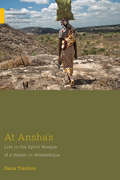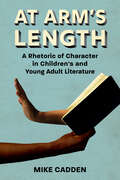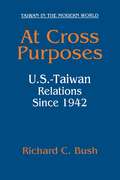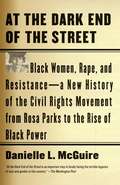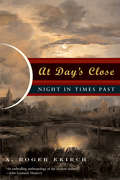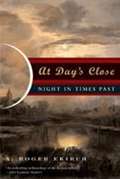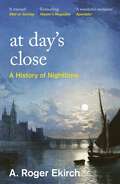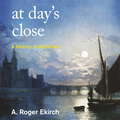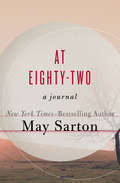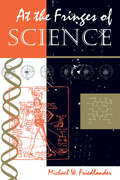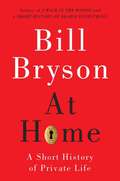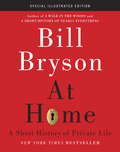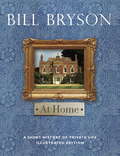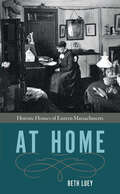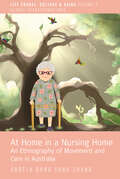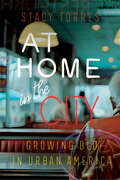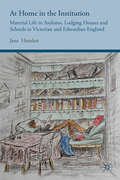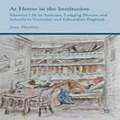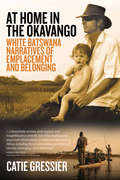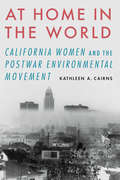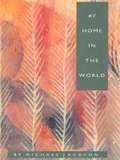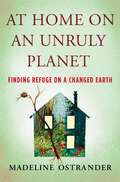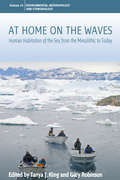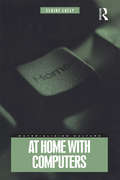- Table View
- List View
At Ansha's: Life in the Spirit Mosque of a Healer in Mozambique (Medical Anthropology)
by Daria TrentiniAt Ansha's takes the reader inside the spirit mosque of a female healer in Nampula, northern Mozambique. It is here that Ansha, a Makonde spirit healer, heals the resisting ailments of her patients, discloses pieces of her story of affliction and healing, and engages the world outside her mosque. We come to know Ansha’s experiences as revolutionary and migrant, her religious trajectories, family, the healers who cured her, the spirits who possessed her, and her declining health. We follow Ansha’s shifts in her life and work in the mosque as these intersect with the visible and invisible borders of Mozambique and of its fraught history. Confronting events in her life and in the mosque between 2009 and 2016, Ansha invites us to make meaning with her, as we sit in her mosque, and engage with her family, spirits, friends, patients, and world.
At Arm’s Length: A Rhetoric of Character in Children’s and Young Adult Literature (Children's Literature Association Series)
by Mike CaddenLiterary critics and authors have long argued about the importance or unimportance of an author’s relationship to readers. What can be said about the rhetorical relationship that exists between author and reader? How do authors manipulate character, specifically, to modulate the emotional appeal of character so a reader will feel empathy, awe, even delight? In At Arm’s Length: A Rhetoric of Character in Children's and Young Adult Literature, Mike Cadden takes a rhetorical approach that complements structural, affective, and cognitive readings. The study offers a detailed examination of the ways authorial choice results in emotional invitation. Cadden sounds the modulation of characters along a continuum from those larger than life and awe inspiring to the life sized and empathetic, down to the pitiable and ridiculous, and all those spaces between. Cadden examines how authors alternate between holding the young reader at arm’s length from and drawing them into emotional intensity. This balance and modulation are key to a rhetorical understanding of character in literature, film, and television for the young. Written in accessible language and of interest and use to undergraduates and seasoned critics, At Arm’s Length provides a broad analysis of stories for the young child and young adult, in book, film, and television. Throughout, Cadden touches on important topics in children’s literature studies, including the role of safety in children’s media, as well as character in multicultural and diverse literature. In addition to treating “traditional” works, he analyzes special cases—forms, including picture books, verse novels, and graphic novels, and modes like comedy, romance, and tragedy.
At Cross Purposes: U.S.-Taiwan Relations Since 1942
by Richard C. BushWritten by the former chairman and managing director of the American Institute in Taiwan, this book sheds new light on key topics in the history of U.S.-Taiwan relations. It fills an important gap in our understanding of how the U.S. government addressed Taiwan and the Taiwan Strait issue from the early 1940s to the present. One theme that runs through these essays is the series of obstacles erected that denied the people of Taiwan a say in shaping their own destiny: Franklin Roosevelt chose to return Taiwan to mainland China for geopolitical reasons; there was little pressure on the Kuomintang to reform its authoritarian rule until Congress got involved in the early 1980s; Chiang Kai-shek spurned American efforts in the 1960s to keep Taiwan in international organizations; and behind the ROC's back, the Nixon, Carter, and Reagan administrations negotiated agreements with the PRC that undermined Taiwan's position. In addition to discussing how the United States reacted to key human rights cases from the 1940s to the 1980s, the author also discusses the Bush and Clinton administrations' efforts to preserve U.S. interests while accommodating new forces in the region. All these episodes have an enduring relevance for the people of Taiwan, and in his conclusion the author discusses where the relationship stands today. The book includes related documents that helped shape the U.S.-Taiwan relationship.
At The Dark End of The Street: Black Women, Rape, and Resistance -- a New History of the Civil Rights Movement From Rosa Parks to The Rise of Black Power
by Danielle L. McguireRosa Parks was often described as a sweet and reticent elderly woman whose tired feet caused her to defy segregation on Montgomery's city buses, and whose supposedly solitary, spontaneous act sparked the 1955 bus boycott that gave birth to the civil rights movement. The truth of who Rosa Parks was and what really lay beneath the 1955 boycott is far different from anything previously written. In this groundbreaking and important book, Danielle McGuire writes about the rape in 1944 of a twenty-four-year-old mother and sharecropper, Recy Taylor, who strolled toward home after an evening of singing and praying at the Rock Hill Holiness Church in Abbeville, Alabama. Seven white men, armed with knives and shotguns, ordered the young woman into their green Chevrolet, raped her, and left her for dead. The president of the local NAACP branch office sent his best investigator and organizer to Abbeville. Her name was Rosa Parks. In taking on this case, Parks launched a movement that ultimately changed the world. The author gives us the never-before-told history of how the civil rights movement began; how it was in part started in protest against the ritualistic rape of black women by white men who used economic intimidation, sexual violence, and terror to derail the freedom movement; and how those forces persisted unpunished throughout the Jim Crow era when white men assaulted black women to enforce rules of racial and economic hierarchy. Black women's protests against sexual assault and interracial rape fueled civil rights campaigns throughout the South that began during World War II and went through to the Black Power movement. The Montgomery bus boycott was the baptism, not the birth, of that struggle. At the Dark End of the Street describes the decades of degradation black women on the Montgomery city buses endured on their way to cook and clean for their white bosses. It reveals how Rosa Parks, by 1955 one of the most radical activists in Alabama, had had enough. "There had to be a stopping place," she said, "and this seemed to be the place for me to stop being pushed around. " Parks refused to move from her seat on the bus, was arrested, and, with fierce activist Jo Ann Robinson, organized a one-day bus boycott. The protest, intended to last twenty-four hours, became a yearlong struggle for dignity and justice. It broke the back of the Montgomery city bus lines and bankrupted the company. We see how and why Rosa Parks, instead of becoming a leader of the movement she helped to start, was turned into a symbol of virtuous black womanhood, sainted and celebrated for her quiet dignity, prim demeanor, and middle-class propriety--her radicalism all but erased. And we see as well how thousands of black women whose courage and fortitude helped to transform America were reduced to the footnotes of history. A controversial, moving, and courageous book; narrative history at its best.
At Day's Close: Night in Times Past
by A. Roger Ekirch"Remarkable....Ekirch has emptied night's pockets, and laid the contents out before us."--Arthur Krystal, The New Yorker Bringing light to the shadows of history through a "rich weave of citation and archival evidence" (Publishers Weekly), scholar A. Roger Ekirch illuminates the aspects of life most often overlooked by other historians--those that unfold at night. In this "triumph of social history" (Mail on Sunday), Ekirch's "enthralling anthropology" (Harper's) exposes the nightlife that spawned a distinct culture and a refuge from daily life. Fear of crime, of fire, and of the supernatural; the importance of moonlight; the increased incidence of sickness and death at night; evening gatherings to spin wool and stories; masqued balls; inns, taverns, and brothels; the strategies of thieves, assassins, and conspirators; the protective uses of incantations, meditations, and prayers; the nature of our predecessors' sleep and dreams--Ekirch reveals all these and more in his "monumental study" (The Nation) of sociocultural history, "maintaining throughout an infectious sense of wonder" (Booklist).
At Day's Close: Night In Times Past
by A. Roger EkirchBringing light to the shadows of history through a "rich weave of citation and archival evidence" (Publishers Weekly), scholar A. Roger Ekirch illuminates the aspects of life most often overlooked by other historians--those that unfold at night. In this "triumph of social history" (Mail on Sunday), Ekirch's "enthralling anthropology" (Harper's) exposes the nightlife that spawned a distinct culture and a refuge from daily life. Fear of crime, of fire, and of the supernatural; the importance of moonlight; the increased incidence of sickness and death at night; evening gatherings to spin wool and stories; masqued balls; inns, taverns, and brothels; the strategies of thieves, assassins, and conspirators; the protective uses of incantations, meditations, and prayers; the nature of our predecessors' sleep and dreams--Ekirch reveals all these and more in his "monumental study" (The Nation) of sociocultural history, "maintaining throughout an infectious sense of wonder" (Booklist).
At Day's Close: A History of Nighttime
by A. Roger EkirchA fascinating and colourful social history of the nighttime in the pre-Industrial era.AT DAY'S CLOSE charts a fresh realm of Western culture, nocturnal life from the late medieval period to the Industrial revolution. The book focuses on the cadences of daily life, investigating nighttime in its own right and resurrecting a rich and complex universe in which persons passed nearly half of their lives - a world, long-lost to historians, of blanket fairs, night freaks, and curtain lectures, of sun-suckers, moon-cursers and night-kings. It is not only the vocabulary that has disappeared, AT DAY'S CLOSE will restitute many facts which have been either lost or forgotten. It is a significant and newsworthy contribution to social history, filled with substantial research, stories and new discoveries.Ekirch uses a wide range of sources to reconstruct how the night was lived in the past : travel accounts, memoirs, letters, poems, plays, court records, coroner's reports, depositions and laws dealing with curfews, crime and lighting. He has analysed working-class autobiographies, proverbs, nursery rhymes, ballads and sermons, and folklore, as well as consulting medical, psychological and anthropological papers.
At Day's Close: A History of Nighttime
by Professor A. Roger EkirchA fascinating and colourful social history of the nighttime.'A wonderful revelation of a vanished age of darkness' SPECTATOR'Fascinating' SUNDAY TIMES'A splendid book ... great entertainment' Sir Patrick Moore'A triumph of social history. Almost every page contains something to surprise the reader ... one of the most enjoyable literary experiences of the year' MAIL ON SUNDAYFrom blanket fairs to night kings, curfews to crime, At Day's Close is an intriguing and captivating investigation into the night. Until now, this rich and complex universe in which we spend nearly half of our lives was a world long-lost to historians. Here, Ekirch explores how the night was lived in the past, through travel accounts, memoirs, letters, folklore, poems, court records and coroner's reports. More than this, it is a passionate argument in the case for less artificial light in an increasingly bright world.
At Eighty-Two: A Journal
by May SartonThe New York Times–bestselling author of At Seventy returns with a memoir about advancing age, including her experience with a series of strokes. In this poignant and fearless account, Sarton chronicles the struggles of life at eighty-two. She juxtaposes the quotidian details of life—battling a leaky roof, sharing an afternoon nap with her cat, the joy of buying a new mattress—with lyrical musings about work, celebrity, devoted friends, and the limitations wrought by the frailties of age. She creates poetry out of everyday existence, whether bemoaning a lack of recognition by the literary establishment or the devastation wrought by a series of strokes. Incapacitated by illness, Sarton relies on friends for the little things she always took for granted. As she becomes more and more aware of &“what holds life together in a workable whole,&” she takes solace in flowers and chocolate and reading letters from devoted fans. This journal takes us into the heart and mind of an extraordinary artist and woman, and is a must-read for Sarton devotees and anyone facing the reality of growing older.This ebook features an extended biography of May Sarton.
At The Fringes Of Science: With A New Epilogue
by Michael W FriedlanderScientific discoveries are constantly in the news. Almost daily we hear about new and important breakthroughs. But sometimes it turns out that what was trumpeted as scientific truth is later discredited, or controversy may long swirl about some dramatic claim.What is a nonscientist to believe? Many books debunk pseudoscience, and some others present only the scientific consensus on any given issue. In At the Fringes of Science Michael Friedlander offers a careful look at the shadowlands of science. What makes Friedlander's book especially useful is that he reviews conventional scientific method and shows how scientists examine the hard cases to determine what is science and what is pseudoscience.Emphasizing that there is no clear line of demarcation between science and nonscience, Friedlander leads the reader through case after entertaining case, covering the favorites of ?tabloid science? such as astrology and UFOs, scientific controversies such as cold fusion, and those maverick ideas that were at first rejected by science only to be embraced later.There are many good stories here, but there is also much learning and wisdom. Students of science and interested lay readers will come away from this book with an increased understanding of what science is, how it works, and how the nonscientist should deal with science at its fringes.
At Home: A Short History of Private Life
by Bill BrysonBryson takes readers on a tour of his house, a rural English parsonage, and finds it crammed with 10,000 years of fascinating historical bric-a-brac. Each room becomes a starting point for a free-ranging discussion of rarely noticed but foundational aspects of social life. A visit to the kitchen prompts disquisitions on food adulteration and gluttony; a peek into the bedroom reveals nutty sex nostrums and the horrors of premodern surgery; in the study we find rats and locusts; a stop in the scullery illuminates the put-upon lives of servants. Bryson follows his inquisitiveness wherever it goes, from Darwinian evolution to the invention of the lawnmower, while savoring eccentric characters and untoward events (like Queen Elizabeth I's pilfering of a subject's silverware). There are many guilty pleasures, from Bryson's droll prose--"What really turned the Victorians to bathing, however, was the realization that it could be gloriously punishing"--to the many tantalizing glimpses behind closed doors at aristocratic English country houses. In demonstrating how everything we take for granted, from comfortable furniture to smoke-free air, went from unimaginable luxury to humdrum routine, Bryson shows us how odd and improbable our own lives really are.
At Home: Special Illustrated Edition
by Bill BrysonFrom one of the most beloved authors of our time--more than six million copies of his books have been sold in this country alone--a fascinating excursion into the history behind the place we call home. "Houses aren't refuges from history. They are where history ends up." Bill Bryson and his family live in a Victorian parsonage in a part of England where nothing of any great significance has happened since the Romans decamped. Yet one day, he began to consider how very little he knew about the ordinary things of life as he found it in that comfortable home. To remedy this, he formed the idea of journeying about his house from room to room to "write a history of the world without leaving home." The bathroom provides the occasion for a history of hygiene; the bedroom, sex, death, and sleep; the kitchen, nutrition and the spice trade; and so on, as Bryson shows how each has figured in the evolution of private life. Whatever happens in the world, he demonstrates, ends up in our house, in the paint and the pipes and the pillows and every item of furniture. Bill Bryson has one of the liveliest, most inquisitive minds on the planet, and he is a master at turning the seemingly isolated or mundane fact into an occasion for the most diverting exposition imaginable. His wit and sheer prose fluency make At Home one of the most entertaining books ever written about private life.
At Home
by Bill BrysonFrom one of the most beloved authors of our time--more than six million copies of his books have been sold in this country alone--a fascinating excursion into the history behind the place we call home. "Houses aren't refuges from history. They are where history ends up." Bill Bryson and his family live in a Victorian parsonage in a part of England where nothing of any great significance has happened since the Romans decamped. Yet one day, he began to consider how very little he knew about the ordinary things of life as he found it in that comfortable home. To remedy this, he formed the idea of journeying about his house from room to room to "write a history of the world without leaving home." The bathroom provides the occasion for a history of hygiene; the bedroom, sex, death, and sleep; the kitchen, nutrition and the spice trade; and so on, as Bryson shows how each has figured in the evolution of private life. Whatever happens in the world, he demonstrates, ends up in our house, in the paint and the pipes and the pillows and every item of furniture. Bill Bryson has one of the liveliest, most inquisitive minds on the planet, and he is a master at turning the seemingly isolated or mundane fact into an occasion for the most diverting exposition imaginable. His wit and sheer prose fluency make At Home one of the most entertaining books ever written about private life.From the Hardcover edition.
At Home: Historic Houses of Eastern Massachusetts
by Beth LueyWith its abundant history of prominent families, Massachusetts boasts some of the most historically rich residences in the country. In the eastern half of the Commonwealth, these include Presidents John and John Quincy Adams's home in Quincy, Bronson and Louisa May Alcott's Orchard House in Concord, the Charles Bulfinch—designed Harrison Gray Otis House in Boston, and Edward Gorey's Elephant House in Yarmouth Port. In At Home: Historic Houses of Eastern Massachusetts, Beth Luey uses architectural and genealogical texts, wills, correspondences, and diaries to craft delightful narratives of these notable abodes and the people who variously built, acquired, or renovated them. Filled with vivid details and fresh perspectives that will surprise even the most knowledgeable aficionados, each chapter is short enough to serve as an introduction for a visit to its house. All the homes are open to the public.
At Home in a Nursing Home: An Ethnography of Movement and Care in Australia (Life Course, Culture and Aging: Global Transformations #9)
by Angela Rong Yang ZhangFocusing on contemporary ideas about how aged care is provided, this book poses the question: How can people who are aged and frail live out the final phase of their lives with dignity? In seeking answers, the author examines what it means to be ‘at home’ in residential care in a novel and compassionate way. In an ethnographic study of how elderly residents can be given the right care, this book provides a new route into the bodily realities of ageing. It is a vital contribution to the search for alternative approaches to aged care provision.
At Home in the City: Growing Old in Urban America
by Stacy TorresUncovers how people aged 60 and older struggle, survive, and thrive in twenty-first-century urban America. To understand elders' experiences of aging in place, sociologist Stacy Torres spent five years with longtime New York City residents as they coped with health setbacks, depression, gentrification, financial struggles, the accumulated losses of neighbors, friends, and family, and other everyday challenges. The sensitive portrait Torres paints in At Home in the City moves us beyond stereotypes of older people as either rich and pampered or downtrodden and frail to capture the multilayered complexity of late life. These pages chronicle how a nondescript bakery in Manhattan served as a public living room, providing company to ease loneliness and a sympathetic ear to witness the monumental and mundane struggles of late life. Through years of careful observation, Torres peels away the layers of this oft-neglected social world and explores the constellation of relationships and experiences that Western culture often renders invisible or frames as a problem. At Home in the City strikes a realistic balance as it highlights how people find support, flex their resilience, and assert their importance in their communities in old age.
At Home in the Institution: Material Life in Asylums, Lodging Houses and Schools in Victorian and Edwardian England
by J. HamlettAt Home in the Institution examines space and material culture in asylums, lodging houses and schools in Victorian and Edwardian England, and explores the powerful influence of domesticity on all three institutional types.
At Home in the Institution
by Jane HamlettAt Home in the Institution takes a new look at institutions in Victorian England, by exploring their material life. The book focuses on asylums, lodging houses and schools - examining decoration and the use of space as well as the things that inmates were allowed. Although all three had very diverse aims, their authorities were often influenced by the relationships, rituals and material culture of contemporary domesticity, demonstrating the reach and importance of these ideas in society. . Yet an assessment of the everyday life of these places often shows the limits of these ideals in practice, the disruptions to domestic routines and the notions of class and gender that they were supposed to inculcate. While the material world was used to control, it also afforded agency to patients, lodgers and pupils - from the schoolboy carving initials on a desk to the pauper lunatics who bred songbirds.
At Home in the Okavango: White Batswana Narratives of Emplacement and Belonging
by Catie GressierAn ethnographic portrayal of the lives of white citizens of the Okavango Delta, Botswana, this book examines their relationships with the natural and social environments of the region. In response to the insecurity of their position as a European-descended minority in a postcolonial African state, Gressier argues that white Batswana have developed cultural values and practices that have allowed them to attain high levels of belonging. Adventure is common for this frontier community, and the book follows their safari lifestyles as they construct and perform localized identities in their interactions with dangerous wildlife, the broader African community, and the global elite via their work in the nature-tourism industry.
At Home in the World: California Women and the Postwar Environmental Movement
by Kathleen A. CairnsFrom the beginning of California&’s statehood, adventurers, scientists, and writers reveled in its majestic landscape. Some were women, though few garnered attention or invitations to join the Sierra Club, the organization created in 1892 to preserve wilderness. Over the next sixty years the Sierra Club and other groups gained prestige and members—including an increasing number of women. But these organizations were not equipped to confront the massive growth of industry that overtook postwar California. This era needed a new approach, and it came from an unlikely source: white, middle-class housewives with no experience in politics. These women successfully battled smog, nuclear power plants, piles of garbage in the San Francisco Bay, and over-building in the Santa Monica Mountains. In At Home in the World Cairns shows how women were at the center of a broader and more inclusive environmental movement that looked beyond wilderness to focus on people&’s daily life. These women challenged the approach long promoted by establishment groups and laid the foundation for the modern environmental movement.
At Home in the World
by Michael JacksonOurs is a century of uprootedness, with fewer and fewer people living out their lives where they are born. At such a time, in such a world, what does it mean to be "at home?" Perhaps among a nomadic people, for whom dwelling is not synonymous with being housed and settled, the search for an answer to this question might lead to a new way of thinking about home and homelessness, exile and belonging. At Home in the World is the story of just such a search. Intermittently over a period of three years Michael Jackson lived, worked, and traveled extensively in Central Australia. This book chronicles his experience among the Warlpiri of the Tanami Desert.Something of a nomad himself, having lived in New Zealand, Sierra Leone, England, France, Australia, and the United States, Jackson is deft at capturing the ambiguities of home as a lived experience among the Warlpiri. Blending narrative ethnography, empirical research, philosophy, and poetry, he focuses on the existential meaning of being at home in the world. Here home becomes a metaphor for the intimate relationship between the part of the world a person calls "self" and the part of the world called "other." To speak of "at-homeness," Jackson suggests, implies that people everywhere try to strike a balance between closure and openness, between acting and being acted upon, between acquiescing in the given and choosing their own fate. His book is an exhilarating journey into this existential struggle, responsive at every turn to the political questions of equity and justice that such a struggle entails.A moving depiction of an aboriginal culture at once at home and in exile, and a personal meditation on the practice of ethnography and the meaning of home in our increasingly rootless age, At Home in the World is a timely reflection on how, in defining home, we continue to define ourselves.
At Home in the World: Women and Charity in Late Qing and Early Republican China
by Professor Xia ShiDuring the years spanning the late Qing dynasty and the early Republican era, the status of Chinese women changed in both subtle and decisive ways. As domestic seclusion ceased to be a sign of virtue, new opportunities emerged for a variety of women. Much scholarly attention has been given to the rise of the modern, independent “new women” during this period. However, far less is known about the stories of married nonprofessional women without modern educations and their public activities.In At Home in the World, Xia Shi unearths the history of how these women moved out of their sequestered domestic life; engaged in charitable, philanthropic, and religious activities; and repositioned themselves as effective public actors in urban Chinese society. Investigating the lives of individual women as well as organizations such as the YWCA and the Daoyuan, she shows how her protagonists built on the past rather than repudiating it, drawing on broader networks of family, marriage, and friendship and reconfiguring existing beliefs into essential components of modern Chinese gender roles. The book stresses the collective forms of agency these women exercised in their endeavors, highlighting the significance of charitable and philanthropic work as political, social, and civic engagement. Shi also analyzes how men—alive, dead, or absent—both empowered and constrained women’s public ventures. She offers a new perspective on how the public, private, and domestic realms were being remade and rethought in early twentieth-century China, in particular, how the women navigated these developing spheres. At Home in the World sheds new light on how women exerted their influence beyond the home and expands the field of Chinese women’s history.
At Home on an Unruly Planet: Finding Refuge on a Changed Earth
by Madeline OstranderFrom rural Alaska to coastal Florida, a vivid account of Americans working to protect the places they call home in an era of climate crisisHow do we find a sense of home and rootedness in a time of unprecedented upheaval? What happens when the seasons and rhythms in which we have built our lives go off-kilter?Once a distant forecast, climate change is now reaching into the familiar, threatening our basic safety and forcing us to reexamine who we are and how we live. In At Home on an Unruly Planet, science journalist Madeline Ostrander reflects on this crisis not as an abstract scientific or political problem but as a palpable force that is now affecting all of us at home. She offers vivid accounts of people fighting to protect places they love from increasingly dangerous circumstances. A firefighter works to rebuild her town after catastrophic western wildfires. A Florida preservationist strives to protect one of North America's most historic cities from rising seas. An urban farmer struggles to transform a California city plagued by fossil fuel disasters. An Alaskan community heads for higher ground as its land erodes.Ostrander pairs deeply reported stories of hard-won optimism with lyrical essays on the strengths we need in an era of crisis. The book is required reading for anyone who wants to make a home in the twenty-first century.
At Home on the Waves: Human Habitation of the Sea from the Mesolithic to Today (Environmental Anthropology and Ethnobiology #24)
by Tanya J. King Gary RobinsonContemporary public discourses about the ocean are routinely characterized by scientific and environmentalist narratives that imagine and idealize marine spaces in which humans are absent. In contrast, this collection explores the variety of ways in which people have long made themselves at home at sea, and continue to live intimately with it. In doing so, it brings together both ethnographic and archaeological research – much of it with an explicit Ingoldian approach – on a wide range of geographical areas and historical periods.
At Home with Computers (Materializing Culture)
by Elaine LallyNew technologies are profoundly reshaping the world around us. Home computers - unheard of two decades ago - now play an intimate role as personal possessions in many people's lives. For some, computer games may be vital to winding-down after a busy day, while for others the home computer represents only work or is a means through which to socialize in cyberspace. Powerfully symbolic of both future and present trends, computers are increasingly seen as essential home purchases. This book is the first sustained examination of the revealing role computers play in our domestic lives. Do computers cause or help to resolve arguments? What role does gender play in negotiating their use? Who spends the most time with the computer? How does the importance of home computers change as we move from childhood through careers to retirement? Drawing upon topical theories from material culture, technology and consumption studies, Lally traces the social life of these machines and provides unique insights into the many different ways in which they are transformed into highly personal possessions. The result is an absorbing account of everyday life in the information age. This book will be of interest to anthropologists, geographers, sociologists and anyone who wants to get to know how their home computer affects their family life.
